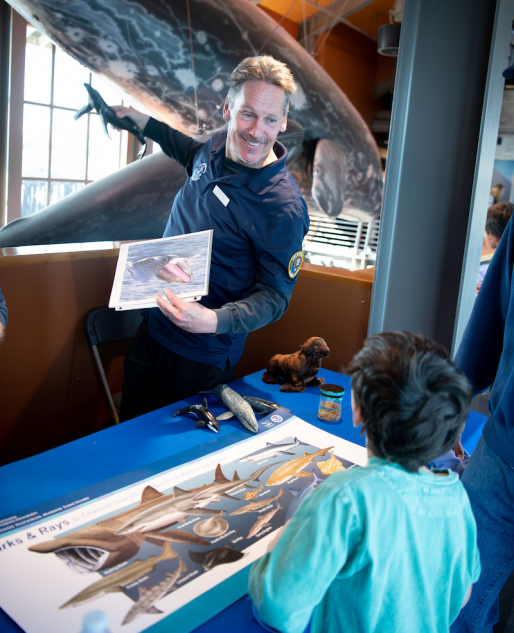Repatriation
Statement on Repatriation
For many decades, the Santa Barbara Museum of Natural History (SBMNH) has been caretaker to a wide variety of Native American material culture. Through careful curation, and public outreach, we are committed to honoring, preserving, and perpetuating this rich and diverse cultural heritage.
In 1990, the Native American Graves Protection and Repatriation Act (NAGPRA) was enacted by Congress—ensuring Indian Tribes, Alaska Natives, and Native Hawai’ians the right to repatriate their ancestral human remains, funerary objects, sacred objects, and objects of cultural patrimony.
While NAGPRA legally requires museums that receive federal funds to provide summary inventories of their collections to affiliated, federally-recognized tribes, and to respond to repatriation requests, the California State version, AB-275 (CalNAGPRA), goes further—requiring proactive consultation with California Indian Tribes regarding affiliation and potential repatriation of human remains and cultural items to the appropriate tribes. The CalNAGPRA process requires engagement with both federally recognized tribes and tribes on the list maintained by the California Native American Heritage Commission (NAHC), especially around human remains and funerary objects that have previously been designated culturally unidentifiable (CUI).
The intent of CalNAGPRA is expedited repatriation of Indian ancestors and their associated funerary objects that have long, and unnecessarily, languished in museum collections. SBMNH is committed to going above and beyond the legal requirements of NAGPRA, engaging with tribes throughout California and beyond, to return all Native American ancestors and their associated funerary objects to their source communities. In keeping with this, the Museum is no longer accepting human remains, Indigenous or otherwise, directly into its ownership and control. Our Department of Anthropology curators are more than happy to assist any individuals or organizations that are in the possession of human remains in identifying the appropriate tribe or organization to contact in order to achieve the proper disposition of the remains.
SBMNH is also committed to a collaborative approach going forward, by deferring to tribal knowledge with regard to cultural affiliation, and also during further identification of sacred objects, objects of cultural patrimony, and other sensitive cultural items in our collections. In keeping with the precepts of tribal sovereignty and self-determination, and in the spirit of restorative social justice and healing, we are committed to fixing the mistakes of the past, and moving forward with ethics and integrity.
The Santa Barbara Museum of Natural History is committed to meaningful consultation and collaboration with tribes. Department of Anthropology staff, including a dedicated NAGPRA Officer, stand ready to address a variety of requests and provide services to support our mission of repatriation. These services can include providing additional collections information such as digital images and scans of original documents, addressing tribal handling and storing protocols, ensuring objects are packaged properly for travel (including a natural materials option), and other actions that will help ensure the proper treatment of ancestors and cultural items. SBMNH staff can also assist with NAGPRA repatriation grant writing, travel coordination, and in-person visits.
Consultation and Collaboration
Proactive and engaged tribal consultation and collaboration is key to successful repatriation outcomes. We strive to incorporate tribal perspectives and priorities into all aspects of our collections management and research practices—from housing objects with culturally appropriate care, in accordance with tribal preferences, to adapting research permissions or access restrictions to comply with tribal protocol.
Whenever possible, the SBMNH encourages in-person visits between our museum staff and tribal representatives. If you’d like to view cultural material, either archaeological or ethnographic, please contact us to schedule a visit. All tribal knowledge shared during a collections review session will be kept strictly confidential unless otherwise agreed upon.
Virtual consultations can also be held via telephone, or video conference call, upon request.
For more information, or to schedule a meeting or visit, tribes may contact our NAGPRA Officer Jonathan Malindine at 805- 642-4711 ext. 142 or jmalindine@sbnature2.org.
SBMNH will not authorize access to, or research on, NAGPRA materials without express permission from authorized tribal representatives.
Additional Resources
Interested parties may find more information through the links provided below, but we look forward to hearing from you directly, in order to answer your questions or assist with coordinating a consultation.
Details about federal law, tribal rights, FAQs, training videos, and grant applications can be found through the National NAGPRA website.
The state version of NAGPRA, California Assembly Bill 275 (AB 275), also known as CalNAGPRA, which includes rights for non-federally recognized tribes, can be found here.
The School for Advanced Research’s Guidelines for Collaboration was developed over a three-year period of collaboration between tribal members, cultural practitioners, museum professionals, and academics. There are two versions of these Guidelines available—one for museums, and one for Tribal Communities.
Resources highlighting the diversity of processes involved in repatriation, and the impact of repatriation on Indigenous communities around the world, have been compiled by tribal members, museum professionals, and academics through the Carrying Our Ancestors Home website.


